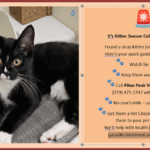
What Do I Do if I Find a Litter of Kittens in Colorado?
August 18, 2025When you hear the word “ringworm,” you might picture a squirmy worm under the skin—but here’s the twist: ringworm is not a worm at all. It’s actually a fungal infection that can affect the skin, hair, and nails of both animals and people.
In cats, dogs, and other pets, ringworm can range from obvious skin lesions to no visible signs at all—and even pets without symptoms can still spread the fungus. That’s why it’s important to know the basics and act quickly if you suspect a problem.
What Causes Ringworm?
Ringworm is caused by a group of fungi called dermatophytes. Some species infect only one type of animal, while others can spread between multiple species—including from pets to humans.
In cats, one specific fungus is responsible for nearly all cases of ringworm. Unfortunately, this same fungus can also infect dogs and people.
How Does Ringworm Spread?
Ringworm is highly contagious. It spreads through:
- Direct contact with an infected pet or person.
- Indirect contact with contaminated items like combs, bedding, furniture, carpets, or food bowls.
- Environmental spores, which can survive for up to 18 months in the right conditions.
Not every exposure leads to infection, but the risk increases with:
- High environmental contamination
- Young, elderly, or immune-compromised animals
- Warm, humid conditions
What Does Ringworm Look Like?
In pets, signs can vary widely:
- Cats: May show “cigarette ash” scaling in the coat, round patches of hair loss, rough or pitted claws, or no signs at all.
- Dogs: Often develop circular patches of hair loss and skin redness.
- Humans: May develop red, itchy, ring-shaped rashes with raised edges.
Because ringworm doesn’t always cause obvious lesions—especially in longhaired cats—diagnosis by a veterinarian is important.
Diagnosis
Your veterinarian may use:
- Wood’s lamp exam: Some ringworm glows yellow-green under UV light.
- Fungal culture: The gold standard test, though results can take 2–3 weeks.
- Additional testing to rule out other causes of hair loss.
Treatment
Ringworm requires both medical treatment and environmental cleaning:
- Topical medications: Antifungal creams, medicated shampoos, or lime sulfur dips.
- Oral antifungal drugs: Such as itraconazole or terbinafine, often for 6+ weeks.
- Environmental cleaning: Daily vacuuming and mopping; disinfecting surfaces with a bleach solution (1 pint bleach to 1 gallon water).
Stopping treatment too early can lead to recurrence, so follow your veterinarian’s instructions closely.
Preventing Spread
While your pet is contagious:
- Limit contact with other pets and people.
- Wear gloves when handling your pet.
- Wash hands thoroughly afterward.
- Clean the environment daily.
Will My Pet Recover?
Most pets recover completely with proper treatment, although stubborn cases may require longer therapy. Two negative fungal cultures usually confirm that the infection is gone.
Protecting Your Family
Because ringworm is zoonotic (can spread to humans), be alert for red, itchy skin patches—especially in children or immune-compromised individuals. Seek medical care if you notice symptoms.
Final Advice
If you suspect your pet has ringworm—or any unusual skin or coat changes—don’t wait. Early diagnosis and treatment will protect your pet, your family, and your other animals.
 Contact your veterinarian right away or call Pikes Peak Veterinary Clinic for advice and treatment options.
Contact your veterinarian right away or call Pikes Peak Veterinary Clinic for advice and treatment options.






